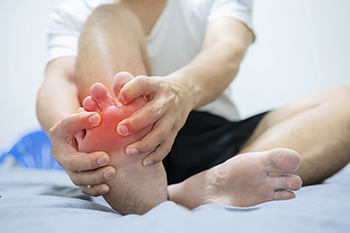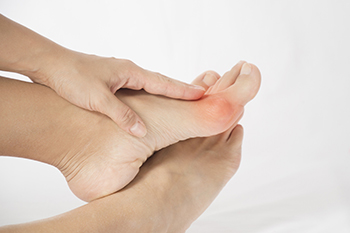Call Us Today! (203) 975-9600
SAME DAY APPOINTMENTS AVAILABLE
November 2022
Ankle Sprains

The ankle is the joint that attaches the foot to the leg. It has bones, ligaments, and tendons, all of which are subject to injury. Ankle pain is any pain or discomfort that affects the ankle. Common causes of ankle pain are sprains, which happen when ligaments connecting bones are injured, or a broken ankle, which is a fracture of the bones in the ankle. Depending on the severity of the ankle pain, one can rest, compress, and elevate their ankle at home and achieve relief. In some cases, one can find it necessary to visit a podiatrist for treatment, such as a cast or surgery. If you have a painful ankle and you have broken it or you are not sure why it hurts but it’s not getting better, visit a podiatrist for a proper diagnosis and healing options.
Ankle pain can be caused by a number of problems and may be potentially serious. If you have ankle pain, consult with one of our podiatrists from Preferred Footcare, LLC. Our doctors will assess your condition and provide you with quality foot and ankle treatment.
Ankle pain is any condition that causes pain in the ankle. Due to the fact that the ankle consists of tendons, muscles, bones, and ligaments, ankle pain can come from a number of different conditions.
Causes
The most common causes of ankle pain include:
- Types of arthritis (rheumatoid, osteoarthritis, and gout)
- Ankle sprains
- Broken ankles
- Achilles tendinitis
- Achilles tendon rupture
- Stress fractures
- Bursitis
- Tarsal tunnel syndrome
- Plantar fasciitis
Symptoms
Symptoms of ankle injury vary based upon the condition. Pain may include general pain and discomfort, swelling, aching, redness, bruising, burning or stabbing sensations, and/or loss of sensation.
Diagnosis
Due to the wide variety of potential causes of ankle pain, podiatrists will utilize a number of different methods to properly diagnose ankle pain. This can include asking for personal and family medical histories and of any recent injuries. Further diagnosis may include sensation tests, a physical examination, and potentially x-rays or other imaging tests.
Treatment
Just as the range of causes varies widely, so do treatments. Some more common treatments are rest, ice packs, keeping pressure off the foot, orthotics and braces, medication for inflammation and pain, and surgery.
If you have any questions, please feel free to contact our office located in Stamford, CT . We offer the newest diagnostic and treatment technologies for all your foot care needs.
Foods That Cause or Worsen Gout

Gout is a type of inflammatory arthritis that results in swelling and severe pain in joints. It often shows itself in the big toe joint first. This condition comes on from having high uric acid levels in the blood and the formation of crystals in the joints. Uric acid is produced when purines, a naturally occurring substance in the body, are broken down and excess acid is not eliminated. Purines can also be found in certain foods, particularly red meats, seafood, high-sugar beverages, alcohol, and beer. It is important to limit the consumption of these foods if one is prone to gout. If you have pain in the joint of your big toe and you think it might be gout or have no idea what it could be from, see a podiatrist who can make an accurate diagnosis and provide treatment.
Gout is a foot condition that requires certain treatment and care. If you are seeking treatment, contact one of our podiatrists from Preferred Footcare, LLC. Our doctors will treat your foot and ankle needs.
What Is Gout?
Gout is a type of arthritis caused by a buildup of uric acid in the bloodstream. It often develops in the foot, especially the big toe area, although it can manifest in other parts of the body as well. Gout can make walking and standing very painful and is especially common in diabetics and the obese.
People typically get gout because of a poor diet. Genetic predisposition is also a factor. The children of parents who have had gout frequently have a chance of developing it themselves.
Gout can easily be identified by redness and inflammation of the big toe and the surrounding areas of the foot. Other symptoms include extreme fatigue, joint pain, and running high fevers. Sometimes corticosteroid drugs can be prescribed to treat gout, but the best way to combat this disease is to get more exercise and eat a better diet.
If you have any questions please feel free to contact our office located in Stamford, CT . We offer the newest diagnostic and treatment technologies for all your foot and ankle needs.
Arthritis Can Cause Pain in the Feet and Ankles
Replacing Running Shoes

Running can be one of the most exhilarating and rewarding ways for some people to get in their daily dose of exercise. However, there are many things an individual may do before, during, and after running that can increase their risk of developing some kind of running injury. One important example is when an individual does not know when to replace their shoes. For example, sometimes the heel of a running shoe will become so worn down that it no longer provides support to the heel of the foot. The heel of the shoe can become worn down for many reasons. One habit that may be damaging the heels of your shoes is failing to lace and unlace the shoes when taking them on and off. By “toeing off” the shoes, you can negatively impact the heel. Contact a podiatrist today for more information about how to protect the heel of your shoes.
All runners should take extra precaution when trying to avoid injury. If you have any concerns about your feet, contact one of our podiatrists of Preferred Footcare, LLC. Our doctors will treat your foot and ankle needs.
How to Prevent Running Injuries
There are a lot of mistakes a runner can make prior to a workout that can induce injury. A lot of athletes tend to overstretch before running, instead of saving those workouts for a post-run routine. Deep lunges and hand-to-toe hamstring pulls should be performed after a workout instead of during a warmup. Another common mistake is jumping into an intense routine before your body is physically prepared for it. You should try to ease your way into long-distance running instead of forcing yourself to rush into it.
More Tips for Preventing Injury
- Incorporate Strength Training into Workouts - This will help improve the body’s overall athleticism
- Improve and Maintain Your Flexibility – Stretching everyday will help improve overall performance
- “Warm Up” Before Running and “Cool Down” Afterward – A warm up of 5-10 minutes helps get rid of lactic acid in the muscles and prevents delayed muscle soreness
- Cross-Training is Crucial
- Wear Proper Running Shoes
- Have a Formal Gait Analysis – Poor biomechanics can easily cause injury
If you have any questions, please feel free to contact our office located in Stamford, CT . We offer the newest diagnostic and treatment technologies for all your foot care needs.
Effects of Aging on the Feet

As a car gets older, its parts start to wear out. This is also true with the feet. Foot problems begin to mount as one ages. This can be attributed to wear and tear, along with a number of other factors. The skin on the feet, along with other parts of the body, begins to lose its elasticity, creating an environment for infections or injuries. The fatty heel pad thins out, causing a loss of cushioning that may increase the likelihood of heel pain. Tendons and ligaments can become looser, leaving one open to strains and sprains. Further, the size of the foot may change as the feet naturally widen with age. It’s suggested that older adults check their shoe size before purchasing new footwear. Shoes that are too tight can invite foot and toe maladies. Finally, certain medical and health conditions, such as diabetes, obesity, and arthritis can affect the circulation of blood to the lower legs, feet, and toes. This can develop into neuropathy, which if not monitored, can lead to serious infections. As an older adult, it is a good idea to make an appointment with a podiatrist to check out the health of your feet.
Proper foot care is something many older adults forget to consider. If you have any concerns about your feet and ankles, contact one of our podiatrists from Preferred Footcare, LLC. Our doctors can provide the care you need to keep you pain-free and on your feet.
The Elderly and Their Feet
As we age we start to notice many changes in our body, but the elder population may not notice them right away. Medical conditions may prevent the elderly to take notice of their foot health right away. Poor vision is a lead contributor to not taking action for the elderly.
Common Conditions
- Neuropathy – can reduce feeling in the feet and can hide many life-threatening medical conditions.
- Reduced flexibility – prevents the ability of proper toenail trimming, and foot cleaning. If left untreated, it may lead to further medical issues.
- Foot sores – amongst the older population can be serious before they are discovered. Some of the problematic conditions they may face are:
- Gouging toenails affecting nearby toe
- Shoes that don’t fit properly
- Pressure sores
- Loss of circulation in legs & feet
- Edema & swelling of feet and ankles
Susceptible Infections
Diabetes and poor circulation can cause general loss of sensitivity over the years, turning a simple cut into a serious issue.
If you have any questions please feel free to contact our office located in Stamford, CT . We offer the newest diagnostic and treatment technologies for all your foot and ankle needs.
All About Bunions

A bunion, or hallux valgus, is when a bony bump occurs on the joint of the big toe. This happens when a few of the bones on the top part of the feet move out of place. As a result of prolonged pressure, the tip of the big toe is pulled toward the smaller toes and forces the joint of the big toe to remain stuck. The skin above the bunion may get red and sore, and calluses might form where the shoe rubs against it. Wearing narrow, tight shoes or standing for a prolonged time might contribute to this condition and make it worse. Bunions can also form from one’s foot shape, a medical problem, such as arthritis, or a foot deformity. Wearing better-fitting shoes, obtaining bunion pads, or using toe spacers might help, and if not, a surgery called a bunionectomy can be performed. The elderly and women are most apt to suffer from this problem. If you have a bunion, consult with a podiatrist who can confirm the diagnosis and suggest the best treatment options for you.
If you are suffering from bunion pain, contact one of our podiatrists of Preferred Footcare, LLC. Our doctors can provide the care you need to keep you pain-free and on your feet.
What Is a Bunion?
Bunions are painful bony bumps that usually develop on the inside of the foot at the joint of the big toe. As the deformity increases over time, it may become painful to walk and wear shoes. Women are more likely to exacerbate existing bunions since they often wear tight, narrow shoes that shift their toes together. Bunion pain can be relieved by wearing wider shoes with enough room for the toes.
Causes
- Genetics – some people inherit feet that are more prone to bunion development
- Inflammatory Conditions - rheumatoid arthritis and polio may cause bunion development
Symptoms
- Redness and inflammation
- Pain and tenderness
- Callus or corns on the bump
- Restricted motion in the big toe
In order to diagnose your bunion, your podiatrist may ask about your medical history, symptoms, and general health. Your doctor might also order an x-ray to take a closer look at your feet. Nonsurgical treatment options include orthotics, padding, icing, changes in footwear, and medication. If nonsurgical treatments don’t alleviate your bunion pain, surgery may be necessary.
If you have any questions, please feel free to contact our office located in Stamford, CT . We offer the newest diagnostic and treatment technologies for all your foot care needs.









